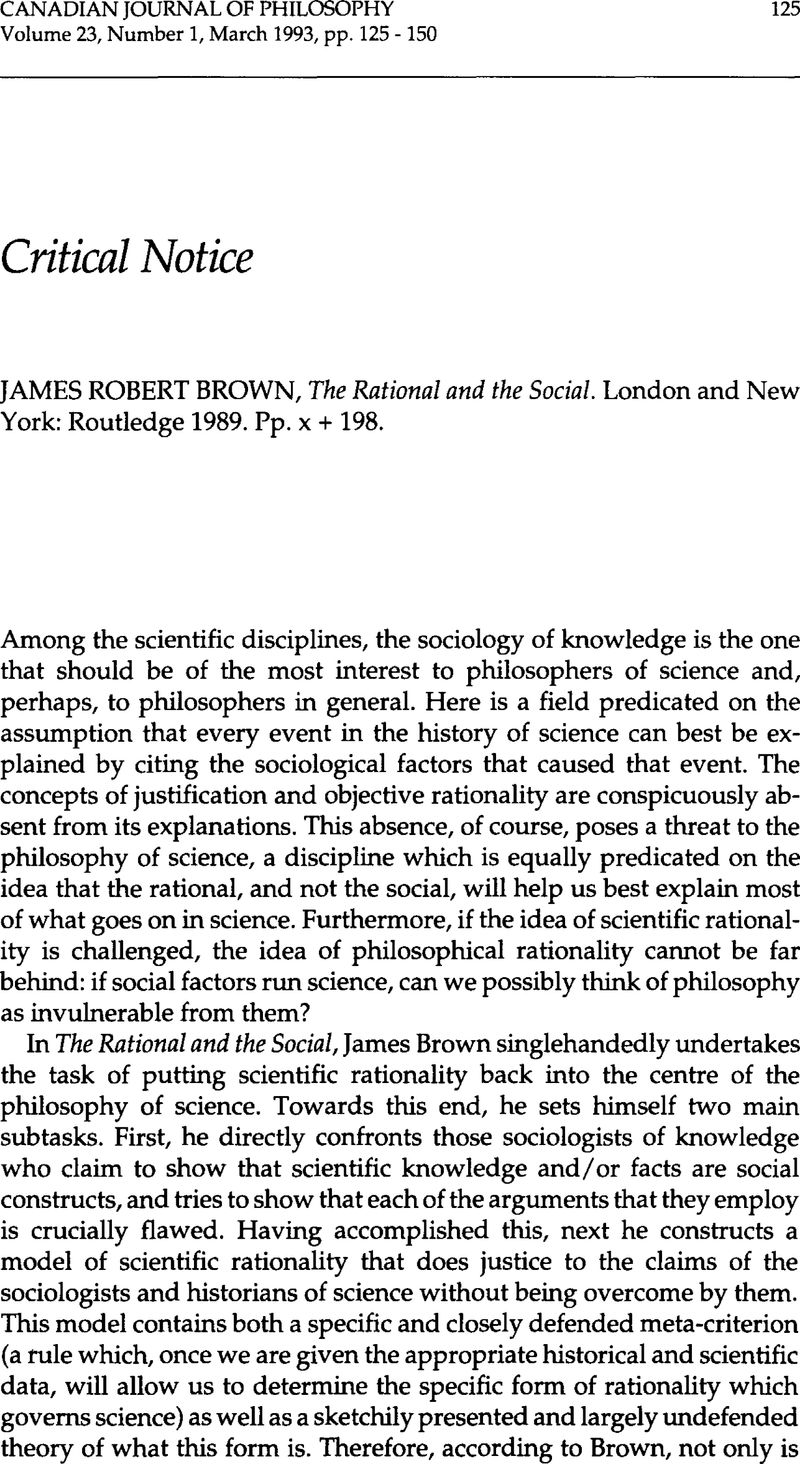Article contents
James Robert Brown The Rational and the Social. London and New York: Routledge 1989. Pp. x + 198.
Review products
Published online by Cambridge University Press: 01 January 2020
Abstract

- Type
- Critical Notice
- Information
- Copyright
- Copyright © The Authors 1987
References
1 Paul Forman, ‘Weimar Culture, Causality, and Quantum Theory, 1918-27: Adaptation by German Physicists and Mathematicians to a Hostile Intellectual Environment,’ in McCormach, R. ed., Historical Studies in the Physical Sciences 3 (Philadelphia: University of Pennsylvania Press 1971)Google Scholar
2 Pickering, Andrew Constructing Quarks (Chicago: University of Chicago Press 1984)Google Scholar
3 Shapin, Steven ‘Phrenological Knowledge and the Social Structure of Early Nineteenth Century Edinburgh,’ Annals of Science 32 (1975) 219-43CrossRefGoogle ScholarPubMed
4 My comments here presuppose that there is an important distinction between the context of discovery and the context of justification. The strong programme could aid its cause by trying to break this distinction, but to date, no convincing arguments have been given against it.
5 Feyerabend, Paul ‘Explanation, Reduction, and Empiricism,’ in Feigl, H. and Maxwell, G. eds., Minnesota Studies in the Philosophy of Science, I (Minneapolis: University of Minnesota Press 1962)Google Scholar
6 Achinstein, Peter Concepts of Science (Baltimore: Johns Hopkins University Press 1968)Google Scholar; Suppe, Fred The StructureofScientific Theories (Chicago: University of Chicago Press 1974)Google Scholar
7 One could possibly try to devise and justify a more limited incommensurability thesis, according to which only those theories which differ in many crucial respects (e.g. Aristotelian vs. relativistic physics) are incommensurable with each other. No successful defense has been given for this limited thesis, although Paul Churchland has done some work towards this end (Scientific Realism and the Plasticity of Mind [Cambridge: Cambridge University Press 1979]). At any rate, this limited thesis would be of very little use to the strong programme, since most of the theoretical conflicts that have occurred in the history of science have been between theories that share many important features in common.
8 Latour, Bruno and Woolgar, S. Laboratory Life: The Social Construction of Scientific Facts (London: Sage 1979)Google Scholar. Although Brown’s refutations of many of the arguments in this book are sound, he does not do justice to Latour’s work as a whole. Once we note that Latour has been accused of being a backsliding realist in the sociological literature, we must question Brown’s labelling him as an unquestioning social constructivist. See Collins, H.M. and Yearley, Steven ‘Epistemological Chicken,’ in Pickering, Andrew ed., Science as Culture and Practice (Chicago: University of Chicago Press 1992) 301-26Google Scholar and Michael Calion and Bruno Latour, ‘Don’t Throw the Baby out with the Bath School!’ 343-68 in the same volume.
9 For a more polemically charged but substantially equivalent treatment by the same author, see Robert Brown, James ‘Latour’s Prosaic Science,’ Canadian Journal of Philosophy 21 (1991) 245-61CrossRefGoogle Scholar.
10 Bloor, David Knowledge and Social Imagery (Chicago: University of Chicago Press 1976)Google Scholar
11 For a critique of the claim that theoretical appraisal must be comparative see Matheson, Carl A. and Kline, A. David ‘Rejection Without Acceptance,’ Australasian Journal of Philosophy 69 (1991) 167-79CrossRefGoogle Scholar.
12 Collins, H.M. Changing Order: Replication and Induction in Scientific Practice (London: Sage 1985), 165Google Scholar. Quoted on p. 95 of Brown’s The Rational and the Social.
13 For a stimulating set of readings on the current status of the sociology of knowledge, see Pickering, Andrew ed., Science as Practice and Culture (Chicago: University of Chicago Press 1992)CrossRefGoogle Scholar.
14 Laudan, Larry Progress and its Problems (Berkeley: University of California Press 1977Google Scholar)
15 Lakatos, Imre ‘History of Science and its Rational Reconstructions,’ in Buck, and Cohen, eds. PSA 1970 (Dordrecht: Reidel 1970), 111Google Scholar
16 Davidson, Donald ‘The Very Idea of a Conceptual Scheme,’ Proceedings of the American Philosophical Association (1973-4)Google Scholar
17 Brown never discusses the link between the explanationist claims he makes in the first half of his book and his espousal of meta-criterion R in the second. If meta-criterion R defines rationality, then what is the status of the assertion that rationality must be explanatory? Conversely, if we are to judge rationality by the extent to which it explains, then how can meta-criterion R (a curve-fitting rule) be definitional? It may be that rationality is by definition explanatory and that meta-criterion R flows out of some criterion for explanatory adequacy, but Brown does not inform us of the nature of the connection.
18 Parts of this paper were read at the University of Manitoba and at a joint session of the 1992 meetings of the Canadian Philosophical Association and the Canadian Society for the History and Philosophy of Science. I wish to thank Jim Brown, Brian Baigrie, Dennis Klimchuk, Rob Shaver, and Bob Bright for comments and conversations that helped me write this paper. Also, the Social Science and Humanities Research Council of Canada provided some resources, and the Institute for the Humanities at the University of Manitoba provided some time.
- 1
- Cited by




